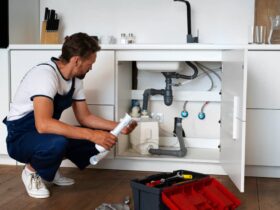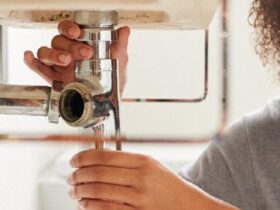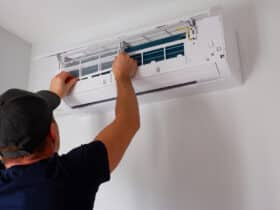If you’re a savvy do-it-yourselfer, you can often fix small problems with your garage door. A few simple steps, like visually inspecting the sensors, cleaning them, and realigning them, can help your garage door work properly.
A rattling sound could mean something is loose or needs to be tightened. Tightening screws and bolts can be a safe DIY fix, but a professional should always adjust torsion springs.
The Door Won’t Open
The garage door opener raises and lowers the door, but it can sometimes get stuck in the open or closed position. This is a serious safety issue; you should only try to fix it yourself if you are a qualified professional.
First, check for obstructions on the ground or in the tracks. Often, it’s just dirt or leaves that have been caught in the way or latches. If these aren’t the problem, you may need to lubricate the rollers with silicone or white lithium lubricant.
Other problems might include a misadjusted sensitivity setting or the photo eye sensor being blocked or covered by something. It’s important to keep these sensors clean to detect objects or people in the way of the door.
The Door Won’t Close
If your garage doors don’t stay closed, a few quick troubleshooting steps can often fix the problem. First, ensure the unit has power, as a non-powered team will not reverse upon closing.
Next, check the photo-eye sensors (two pea-sized LED laser beams that align face-to-face across each side of the opener). These safety devices help prevent the garage door from closing on small children, pets, or obstructions, keeping your family safe.
The lenses on these sensors can become dirty, and a simple wiping often fixes the issue. Also, they may need to be realigned if they have been moved or knocked out of alignment. Finally, if your door reverses upon closing, the limit settings need to be recalibrated. A professional from a garage door company can help with this.
The Door Is Noisy
When your garage door is noisy, it’s most likely because of metal-on-metal contact points or it needs lubrication. To troubleshoot the problem, turn off the power to your garage door so you can work safely and avoid injuring yourself or damaging your belongings.
Start with the door hinges. These metal parts allow the door to fold up and down; if they’re loose or damaged, they can cause the noise you hear. Tighten loose bolts and spray them with lubricant to prevent the problem from returning.
Metal rollers can also cause a grinding sound, so try switching them to nylon ones. They’re quieter and don’t require lubrication as often. However, if the problem persists, call a professional. The issue may be more severe and need a replacement part.
The Door Is Stuck in the Open Position
The door is stuck in the open position when objects or debris prevent it from swinging closed. This can include things such as leaves or dust along the hinges, a new rug that hasn’t been properly anchored to the floor, or a rock or other obstruction at the base of the door.
Alternatively, the door could rub against the frame or threshold when it moves up and down. To locate where this is happening, close the door and carry a piece of paper or a thin object along the gap between the door and frame. This will indicate where the contact is strongest. A block plane is a tool that can be used to smooth and shape wood, and it can fix a sticking door by shaving off thin layers of wood until the problem areas are no longer touching each other.
The Door Is Off Balance
A garage door that is off balance can cause it to rub against the frame when it opens and closes. This could be caused by wood swelling from humidity or loose hinge screws that allow the door to sag enough to brush against the frame.
You can fix this by shimming the hinges. To do this, use a long screw to make a new hole on the side of the hinge where it is rubbing against the frame. Make sure to countersink the screw head and cover it with wood filler before reinstalling it.
This will draw the hinge closer to the doorjamb and help to keep it from rubbing against it. Another option is to adjust the spring tension by moving the adjusting collar up or down on the torsion rod.













